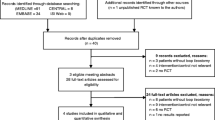Abridged Abstract [1]
Background
This is the first systematic review specifically investigating ileocolic anastomosis.
Objectives
To compare outcomes of ileocolic anastomoses performed using stapling and handsewn techniques. The hypothesis tested was that the stapling technique is associated with fewer complications.
Search strategy
MEDLINE, EMBASE, Cochrane Colorectal Cancer Group specialised register SR-COLOCA, and Cochrane Library were searched for randomised controlled trials comparing the use of a linear cutter stapler with any type of suturing technique for ileocolic anastomoses in adults from 1970 to 2005. Selection criteria were randomised controlled trials comparing the use of linear cutter stapler (isoperistaltic side to side or functional end to end) with any type of suturing technique in adults. Regarding data collection and analysis, eligible studies were selected and their methodological quality assessed. Sub-group analyses for cancer and inflammatory bowel disease as indication for ileocolic anastomoses were performed.
Results
Six trials (including one unpublished) with 955 ileocolic participants were included. The three largest trials had adequate allocation concealment. Stapled anastomosis was associated with significantly fewer anastomotic leaks compared with the handsewn technique (S = 5/357, HS = 36/598, OR 0.34 [0.14, 0.82] p = 0.02). For the sub-group of 825 cancer patients in four studies, stapled anastomosis led to significantly fewer anastomotic leaks (S = 4/300, HS = 35/525, OR 0.28 [0.10, 0.75] p = 0.01). There were very less Crohn’s disease patients to perform a sub-group analysis. All other outcomes showed no significant difference.
Conclusions
Stapled functional end-to-end ileocolic anastomosis is associated with fewer leaks than handsewn anastomosis.
Similar content being viewed by others
References
Choy PYG, Bissett IP, Docherty JG, Parry BR, Merrie AEH (2007) Stapled versus handsewn methods for ileocolic anastomoses. Cochrane Database Syst Rev. https://doi.org/10.1002/14651858.CD004320.pub2
Simillis C, Purkayastha S, Yamamoto T, Strong SA, Darzi AW, Tekkis PP (2007) A meta-analysis comparing conventional end-to-end anastomosis vs. other anastomotic configurations after resection in Crohn’s disease. Dis Colon Rectum 50(10):1674–1687. https://doi.org/10.1007/s10350-007-9011-8
He X, Chen Z, Huang J et al (2014) Stapled side-to-side anastomosis might be better than handsewn end-to-end anastomosis in ileocolic resection for Crohn’s disease: a meta-analysis. Dig Dis Sci 59(7):1544–1551. https://doi.org/10.1007/s10620-014-3039-0
Feng JS, Li JY, Yang Z, Chen XY, Mo JJ, Li SH (2018) Stapled side-to-side anastomosis might be benefit in intestinal resection for Crohn’s disease. Medicine (United States). https://doi.org/10.1097/MD.0000000000010315
Bemelman WA, Warusavitarne J, Sampietro GM et al (2018) ECCO-ESCP consensus on surgery for Crohn’s disease. J Crohns Colitis. https://doi.org/10.1093/ecco-jcc/jjx061
Brown SR, Fearnhead NS, Faiz OD et al (2018) The Association of Coloproctology of Great Britain and Ireland consensus guidelines in surgery for inflammatory bowel disease. Color Dis. https://doi.org/10.1111/codi.14448
Kono T, Ashida T, Ebisawa Y et al (2011) A new antimesenteric functional end-to-end handsewn anastomosis: surgical prevention of anastomotic recurrence in Crohn’s disease. Dis Colon Rectum 54(5):586–592. https://doi.org/10.1007/DCR.0b013e318208b90f
Anthony A, Dhillon AP, Pounder RE, Wakefield AJ (1997) Ulceration of the ileum in Crohn’s disease: correlation with vascular anatomy. J Clin Pathol 50(12):1013–1017
Kono T, Fichera A, Maeda K et al (2016) Kono-S anastomosis for surgical prophylaxis of anastomotic recurrence in Crohn’s disease: an International Multicenter Study. J Gastrointest Surg 20(4):783–790. https://doi.org/10.1007/s11605-015-3061-3
Shimada N, Ohge H, Kono T et al (2019) Surgical recurrence at anastomotic site after bowel resection in Crohn’s disease: comparison of Kono-S and End-to-end anastomosis. J Gastrointest Surg. https://doi.org/10.1007/s11605-018-4012-6
Coffey JC, Kiernan MG, Sahebally SM et al (2018) Inclusion of the mesentery in ileocolic resection for Crohn’s disease is associated with reduced surgical recurrence. J Crohn’s Colitis. https://doi.org/10.1093/ecco-jcc/jjx187
Luglio G, Rispo A, Castiglione F et al (2016) Kono-type anastomosis in a patient with severe multi-recurrent Crohn’s disease. Int J Colorectal Dis. https://doi.org/10.1007/s00384-016-2567-9
Imperatore N, Rispo A, Luglio G, Bucci L, Castiglione F (2018) Letter: which risk factors for post-operative recurrence in Crohn’s disease can be modified? Aliment Pharmacol Ther. https://doi.org/10.1111/apt.14989
Michelassi F (2014) Crohn’s recurrence after intestinal resection and anastomosis. Dig Dis Sci. https://doi.org/10.1007/s10620-014-3096-4
Author information
Authors and Affiliations
Corresponding author
Ethics declarations
Conflict of interest
The authors declare that they have no conflict of interest.
Ethical approval
All procedures performed in studies involving human participants were in accordance with the ethical standards of the institutional and national research committee and with the 1964 Helsinki Declaration and its later amendments.
Informed consent
Formal consent is not required for the study.
Additional information
Publisher's Note
Springer Nature remains neutral with regard to jurisdictional claims in published maps and institutional affiliations.
Rights and permissions
About this article
Cite this article
Luglio, G., Corcione, F. Stapled versus handsewn methods for ileocolic anastomoses. Tech Coloproctol 23, 1093–1095 (2019). https://doi.org/10.1007/s10151-019-02105-8
Received:
Accepted:
Published:
Issue Date:
DOI: https://doi.org/10.1007/s10151-019-02105-8




